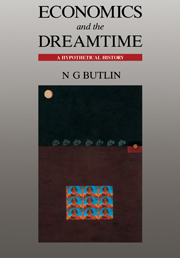Book contents
- Frontmatter
- Contents
- Preface
- Acknowledgements
- Figures
- Maps
- Tables
- Introduction
- Part I The palaeoeconomic history of Aboriginal migration
- Part II Development, structure and function of Aboriginal economy
- 7 Introduction
- 8 The process of early settlement
- 9 Variety in the precontact Aboriginal economy
- 10 The nature and function of Aboriginal economy
- 11 Dynamic elements in the Aboriginal economy
- Part III Disease, economics and demography
- Part IV The establishment of a bridgehead economy: 1788–1810
- Part V The takeover process: 1788–1850
- Bibliography
- Appendix 1 Preliminary model/checklist of Aboriginal migration to Australia
- Appendix 2 NOAA depth contour maps
- Index
8 - The process of early settlement
Published online by Cambridge University Press: 06 July 2010
- Frontmatter
- Contents
- Preface
- Acknowledgements
- Figures
- Maps
- Tables
- Introduction
- Part I The palaeoeconomic history of Aboriginal migration
- Part II Development, structure and function of Aboriginal economy
- 7 Introduction
- 8 The process of early settlement
- 9 Variety in the precontact Aboriginal economy
- 10 The nature and function of Aboriginal economy
- 11 Dynamic elements in the Aboriginal economy
- Part III Disease, economics and demography
- Part IV The establishment of a bridgehead economy: 1788–1810
- Part V The takeover process: 1788–1850
- Bibliography
- Appendix 1 Preliminary model/checklist of Aboriginal migration to Australia
- Appendix 2 NOAA depth contour maps
- Index
Summary
A mere 25 years ago, the common assumption was that Aborigines had settled Australia during only the past 10,000 years or so and that they naturally congregated on coastal areas, spread more thinly along inland riverine locations and dispersed sparsely over the arid interior. Until much more recently, it was universally accepted that the Aboriginal population of Australia as a whole had reached only 300,000 or so at the time of European settlement. Though there is still debate and doubt about the size of the immediate precontact population, this picture of Aboriginal occupation has been radically revised, particularly as a result of prehistorians' efforts since about 1965.
Map 7 (p. 58) summarises present understanding of the range of dated locations, as currently estimated, of Aboriginal settlement prior to 10,000 BP. The map does not report all finds and dates, merely the oldest reasonably firmly established ‘dates’, according to radio-carbon dating methods, at each major location. Even now, three important reservations must be made. First, new finds must be expected, possibly altering the implied perspective. Second, radio-carbon dating is limited to identifying ‘dates’ up to about 40,000 BP, with rapidly increasing orders of error as that length of time is approached. Improved techniques may extend times further back. Thirdly, some sites are known to contain material at present undateable or difficult to determine, with the probability of more ancient material remains, so that understatements may occur for this reason also.
- Type
- Chapter
- Information
- Economics and the DreamtimeA Hypothetical History, pp. 57 - 65Publisher: Cambridge University PressPrint publication year: 1993



